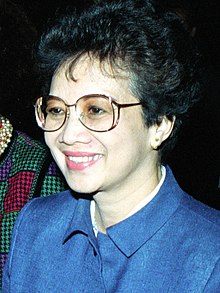 | |
| Presidency of Corazon Aquino February 25, 1986 – June 30, 1992 | |
Corazon C. Aquino | |
| Cabinet | See list |
| Party | UNIDO |
| Election | 1986 |
| Seat | Malacañang Palace, Manila |
|
| |
| ||
|---|---|---|
|
President of the Philippines
Post-Presidency |
||
Corazon Aquino became the 11th President of the Philippines following the People Power Revolution or EDSA 1, and spanned a six-year period from February 25, 1986, to June 30, 1992. Aquino's relatively peaceful ascension to the Philippine presidency signaled the end of authoritarian rule of Ferdinand Marcos in the Philippines, and drew her and the Filipino people international acclaim and admiration.
During the first months of Aquino's presidency, the country experienced radical changes and sweeping democratic reforms. Aquino created the Presidential Commission on Good Government (PCGG), which was tasked to go after the Marcos ill-gotten wealth; however, after her presidency, the PCGG itself was also implicated by corruption scandals when it was alleged that officials wanted a cut of the Marcos assets and officials were "milking" sequestered assets.[1][2][3] Aquino, being a revolutionary president by virtue of people power, repealed and abolished repressive laws under her predecessor, restored civil liberties, abolished the 1973 "Marcos Constitution" and dissolved the Marcos allies, loyalists, supporters-dominated Batasang Pambansa, despite the advice of her vice-president and only prime minister Salvador Laurel. She also immediately created a Constitutional Commission, which she directed for the drafting of a new constitution for the nation.
- ^ Stich, Rodney (November 24, 2010). Japanese and U.S. World War II Plunder and Intrigue. Silverpeak Enterprises. p. 169. ISBN 9780932438706.
- ^ Solmerin, Zaff (January 5, 2009). "Corruption, power struggle mar PCGG work in 2008". ABS-CBN News. Business Mirror. Archived from the original on September 23, 2016. Retrieved January 2, 2023.
- ^ Ronda, Rainier Allan (February 15, 2012). "Ex-PCGG chief Sabio found guilty of grave misconduct". The Philippine Star. Archived from the original on March 7, 2021. Retrieved January 2, 2023.

